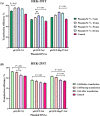Which one of the thermal approaches (heating DNA or cells) enhances the gene expression in mammalian cells?
- PMID: 34482511
- PMCID: PMC8418791
- DOI: 10.1007/s10529-021-03176-0
Which one of the thermal approaches (heating DNA or cells) enhances the gene expression in mammalian cells?
Abstract
Objectives: Heat treatment as a physical method could increase the cellular uptake of nucleic acids. In this study, the effects of heat shock were evaluated to enhance the transfection efficiency of three plasmid DNAs into HeLa and TC-1 cancerous, and HEK-293 T and Vero non-cancerous cell lines using lipofectamine 2000 reagent.
Methods: Two methods of cell- and DNA-based heat treatment were used. Heating DNA solution was performed at 94 °C for 5, 10 and 15 min, and also 72 °C for 30, 60 and 120 min, individually. Moreover, heating the cells was done by incubation at 42 °C for 2 h in different times such as before, during and after DNA transfection.
Results: Our data showed that the conformation of plasmid DNAs was changed at different temperatures with increasing time. The heat-treated plasmid DNAs (94 °C for 10 min or 72 °C for 30 min) indicated higher transfection efficiency than untreated plasmid DNAs (p < 0.05). Furthermore, heat treatment of cells before and during the transfection was higher than untreated cells (p < 0.01). Our results demonstrated that DNA transfection efficiency in cancerous cells was less than non-cancerous cells (p < 0.01).
Conclusion: Generally, these findings showed that transfection mediated by thermal stimulation could enhance gene transfection in mammalian cell lines.
Keywords: Gene delivery; HIV-1; Heat shock protein; Heat treatment; Nef; Transfection.
© 2021. The Author(s), under exclusive licence to Springer Nature B.V.
Conflict of interest statement
The authors declare no conflict of interest.
Figures





Similar articles
-
Delivery of HIV-1 Nef linked to heat shock protein 27 using a cationic polymer is more effective than cationic lipid in mammalian cells.Bratisl Lek Listy. 2017;118(6):334-338. doi: 10.4149/BLL_2017_064. Bratisl Lek Listy. 2017. PMID: 28664742
-
A method to increase the bioactivity of plasmid DNA by heat treatment.J Biochem Biophys Methods. 2008 Apr 24;70(6):1066-72. doi: 10.1016/j.jprot.2008.01.013. Epub 2008 Feb 15. J Biochem Biophys Methods. 2008. PMID: 18346792
-
In Vitro Anti-Viral Effects of Small Heat Shock Proteins 20 and 27: A Novel Therapeutic Approach.Curr Pharm Biotechnol. 2019;20(12):1011-1017. doi: 10.2174/1389201020666190729104648. Curr Pharm Biotechnol. 2019. PMID: 31362669
-
Study of mechanisms of electric field-induced DNA transfection. V. Effects of DNA topology on surface binding, cell uptake, expression, and integration into host chromosomes of DNA in the mammalian cell.Biophys J. 1993 Oct;65(4):1684-9. doi: 10.1016/S0006-3495(93)81208-6. Biophys J. 1993. PMID: 8274656 Free PMC article.
-
[Nanoparticle-mediated endostatin gene therapy targeting hepatocellular carcinoma utilizing heat-inducible promoter].Zhonghua Yi Xue Za Zhi. 2009 Mar 31;89(12):795-9. Zhonghua Yi Xue Za Zhi. 2009. PMID: 19595115 Chinese.
Cited by
-
Plasmid Delivery and Single-Cell Plasmid Expression Analysis for CRISPR/dCas9-Based Epigenetic Editing.Methods Mol Biol. 2024;2842:255-265. doi: 10.1007/978-1-0716-4051-7_13. Methods Mol Biol. 2024. PMID: 39012600
-
Improvement strategies for transient gene expression in mammalian cells.Appl Microbiol Biotechnol. 2024 Oct 4;108(1):480. doi: 10.1007/s00253-024-13315-y. Appl Microbiol Biotechnol. 2024. PMID: 39365308 Free PMC article. Review.
References
MeSH terms
Substances
LinkOut - more resources
Full Text Sources
Miscellaneous

